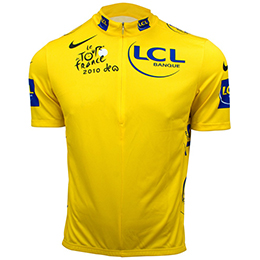Unlocking the Secrets of the Tour de France Jerseys
The Tour de France, one of the most prestigious cycling events in the world, is steeped in tradition and pageantry. Among the most iconic symbols of the Tour are the jerseys worn by the riders, each with its own unique meaning and significance. The Tour de France jersey color meaning is a topic of great interest among cycling enthusiasts, and understanding the history and significance of each color can add a new layer of appreciation to the sport.
The Tour de France jerseys have been a part of the event since its inception in 1903. The original jersey was yellow, and it was awarded to the overall leader of the Tour. Over the years, additional jerseys have been introduced, each with its own specific meaning and criteria for awarding. Today, there are four main jerseys: the Yellow Jersey, the Green Jersey, the Polka Dot Jersey, and the White Jersey.
Each jersey has its own unique history and significance, and understanding the Tour de France jersey color meaning can provide valuable insights into the sport. The Yellow Jersey, for example, is awarded to the overall leader of the Tour, and is considered the most prestigious of the four jerseys. The Green Jersey, on the other hand, is awarded to the rider who accumulates the most points in the sprint stages, and is a symbol of sprinting excellence.
The Polka Dot Jersey is awarded to the King of the Mountains, and is a nod to the challenging mountain stages that are a hallmark of the Tour. The White Jersey, meanwhile, is awarded to the best young rider in the Tour, and is a recognition of the importance of nurturing young talent in professional cycling.
Throughout the years, the Tour de France jerseys have undergone changes in design, color, and sponsorship. However, the core meaning and significance of each jersey have remained the same. Understanding the Tour de France jersey color meaning is essential to appreciating the rich history and tradition behind the iconic jerseys.
How to Identify the Leader of the Pack
The Yellow Jersey is one of the most iconic and coveted jerseys in the Tour de France, and its significance is deeply rooted in the history of the sport. The Yellow Jersey is awarded to the overall leader of the Tour de France, and it is considered the most prestigious of the four jerseys. The jersey is yellow because the original sponsor of the Tour de France, L’Auto, was a French sports newspaper with yellow pages.
The Yellow Jersey has been awarded to the overall leader of the Tour de France since the first edition of the race in 1903. The jersey is awarded to the rider who has the lowest cumulative time at the end of each stage, and it is worn by the leader on the following stage. The Yellow Jersey is a symbol of excellence and achievement, and it is considered a great honor to wear it.
Some of the most notable past winners of the Yellow Jersey include Jacques Anquetil, Bernard Hinault, and Lance Armstrong. These riders have all made significant contributions to the sport, and their achievements continue to inspire and motivate riders today. The Yellow Jersey is a reminder of the rich history and tradition of the Tour de France, and it continues to be an important part of the sport.
In addition to its historical significance, the Yellow Jersey also has a practical purpose. It allows spectators and other riders to easily identify the leader of the pack, and it provides a visual reminder of the rider’s achievement. The Yellow Jersey is also an important marketing tool, as it provides a visible symbol of the rider’s success and helps to promote the sport.
Understanding the Tour de France jersey color meaning is essential to appreciating the significance of the Yellow Jersey. The Yellow Jersey is more than just a symbol of excellence – it is a reminder of the rich history and tradition of the sport, and it continues to play an important role in the Tour de France today.
The Green Jersey: A Symbol of Sprinting Excellence
The Green Jersey is one of the most coveted jerseys in the Tour de France, and it is awarded to the rider who accumulates the most points in the sprint stages. The Green Jersey is a symbol of sprinting excellence, and it is considered one of the most prestigious jerseys in the sport. The jersey is green because it was originally sponsored by a French tea company, and the color has remained the same to this day.
The scoring system for the Green Jersey is based on a points system, where riders earn points for finishing in the top positions in each stage. The rider with the most points at the end of the Tour de France is awarded the Green Jersey. The points system is designed to reward riders who are consistent and skilled in the sprint stages, and it provides a thrilling competition for fans to follow.
Some of the most notable past winners of the Green Jersey include Peter Sagan, Mark Cavendish, and Robbie McEwen. These riders are known for their exceptional sprinting abilities, and they have all made significant contributions to the sport. The Green Jersey is a reminder of the importance of sprinting in the Tour de France, and it continues to be an exciting and unpredictable competition.
In addition to its significance in the Tour de France, the Green Jersey also has a broader impact on the sport. It provides a platform for riders to showcase their skills and compete against the best in the world. The Green Jersey also helps to promote the sport, as it provides a visible symbol of excellence and achievement.
Understanding the Tour de France jersey color meaning is essential to appreciating the significance of the Green Jersey. The Green Jersey is more than just a symbol of sprinting excellence – it is a reminder of the rich history and tradition of the sport, and it continues to play an important role in the Tour de France today.
Conquering the Mountains: The Polka Dot Jersey
The Polka Dot Jersey is one of the most iconic and coveted jerseys in the Tour de France, and it is awarded to the King of the Mountains. The jersey is white with polka dots, and it is considered a symbol of excellence and achievement in the mountain stages. The Polka Dot Jersey was first introduced in 1975, and it has been a staple of the Tour de France ever since.
The King of the Mountains is awarded to the rider who accumulates the most points in the mountain stages. The points system is based on the difficulty of the climb, with more points awarded for the most challenging climbs. The rider with the most points at the end of the Tour de France is awarded the Polka Dot Jersey.
Competing in the mountain stages is one of the most challenging aspects of the Tour de France. The climbs are steep and grueling, and the riders must have a high level of endurance and strength to succeed. The Polka Dot Jersey is a testament to the riders who have mastered the art of climbing, and it is considered one of the most prestigious jerseys in the sport.
Some of the most notable past winners of the Polka Dot Jersey include Richard Virenque, Laurent Jalabert, and Michael Rasmussen. These riders are known for their exceptional climbing abilities, and they have all made significant contributions to the sport. The Polka Dot Jersey is a reminder of the importance of climbing in the Tour de France, and it continues to be an exciting and unpredictable competition.
In addition to its significance in the Tour de France, the Polka Dot Jersey also has a broader impact on the sport. It provides a platform for riders to showcase their skills and compete against the best in the world. The Polka Dot Jersey also helps to promote the sport, as it provides a visible symbol of excellence and achievement.
Understanding the Tour de France jersey color meaning is essential to appreciating the significance of the Polka Dot Jersey. The Polka Dot Jersey is more than just a symbol of climbing excellence – it is a reminder of the rich history and tradition of the sport, and it continues to play an important role in the Tour de France today.
White Jersey: The Future of Cycling
The White Jersey is a prestigious award in the Tour de France, given to the best young rider in the competition. The jersey is white, and it is considered a symbol of hope and promise for the future of cycling. The White Jersey was first introduced in 1975, and it has been a staple of the Tour de France ever since.
To be eligible for the White Jersey, riders must be under the age of 26 and have a high level of performance in the Tour de France. The jersey is awarded to the rider who has the lowest cumulative time in the general classification, and it is considered a great honor to wear the White Jersey.
The White Jersey is important because it recognizes the achievements of young riders and provides a platform for them to showcase their skills. The jersey is also a symbol of the future of cycling, and it highlights the importance of nurturing young talent in the sport.
Some of the most notable past winners of the White Jersey include Eddy Merckx, Bernard Hinault, and Greg LeMond. These riders went on to have successful careers in professional cycling, and they are considered some of the greatest riders of all time.
The White Jersey is also a reminder of the importance of youth development in cycling. The jersey provides a platform for young riders to gain experience and develop their skills, and it helps to promote the sport among young people.
Understanding the Tour de France jersey color meaning is essential to appreciating the significance of the White Jersey. The White Jersey is more than just a symbol of youth and promise – it is a reminder of the rich history and tradition of the sport, and it continues to play an important role in the Tour de France today.
Team Classification: The Importance of Teamwork
The team classification jersey is a prestigious award in the Tour de France, given to the team with the lowest cumulative time. The jersey is a symbol of teamwork and collaboration, and it highlights the importance of working together to achieve a common goal.
The team classification jersey is awarded to the team with the lowest cumulative time, based on the times of the top three riders from each team. The team with the lowest cumulative time is considered the winner of the team classification, and they are awarded the team classification jersey.
Teamwork is a crucial aspect of the Tour de France, and the team classification jersey is a reminder of the importance of collaboration and cooperation. The jersey is a symbol of the hard work and dedication that goes into preparing for the Tour de France, and it highlights the importance of teamwork in achieving success.
Some of the most notable team performances in the Tour de France include the dominance of the US Postal Service team in the early 2000s, led by Lance Armstrong, and the success of the Sky team in the 2010s, led by Chris Froome. These teams demonstrated the importance of teamwork and collaboration in achieving success in the Tour de France.
The team classification jersey is also a reminder of the importance of strategy and tactics in the Tour de France. Teams must work together to develop a strategy for the race, and they must be able to adapt to changing circumstances and challenges. The team classification jersey is a symbol of the hard work and dedication that goes into preparing for the Tour de France, and it highlights the importance of teamwork in achieving success.
Understanding the Tour de France jersey color meaning is essential to appreciating the significance of the team classification jersey. The team classification jersey is more than just a symbol of teamwork – it is a reminder of the rich history and tradition of the sport, and it continues to play an important role in the Tour de France today.
Jersey Changes Throughout the Years
The Tour de France jerseys have undergone significant changes over the years, reflecting the evolution of the sport and the influence of various sponsors and designers. From the original yellow jersey introduced in 1919 to the modern-day designs, the jerseys have become an integral part of the Tour de France’s identity.
One of the most notable changes to the jerseys was the introduction of the green jersey in 1953, which was originally sponsored by the French tea company, L’Auto. The green jersey was designed to promote the company’s tea brand and has since become a symbol of sprinting excellence in the Tour de France.
In the 1960s and 1970s, the Tour de France jerseys underwent significant design changes, with the introduction of new colors and logos. The polka dot jersey, introduced in 1975, was designed to promote the French chocolate company, Chocolat Poulain. The jersey has since become a symbol of the King of the Mountains competition.
In recent years, the Tour de France jerseys have continued to evolve, with the introduction of new sponsors and designers. The white jersey, introduced in 1975, was originally sponsored by the French bank, Crédit Lyonnais. The jersey has since become a symbol of the best young rider in the Tour de France.
The team classification jersey has also undergone significant changes over the years, with the introduction of new sponsors and designers. The jersey is currently sponsored by the French bank, FDJ, and is awarded to the team with the lowest cumulative time.
Despite the changes to the jerseys over the years, the Tour de France jersey color meaning has remained consistent. The jerseys continue to be an integral part of the sport, providing a visual representation of the riders’ achievements and the teams’ performances.
Understanding the evolution of the Tour de France jerseys is essential to appreciating the significance of the jerseys in the sport. The jerseys have become an iconic part of the Tour de France’s identity, and their changes over the years reflect the evolution of the sport and the influence of various sponsors and designers.
Conclusion: The Enduring Legacy of the Tour de France Jerseys
The Tour de France jerseys are an integral part of the sport, providing a visual representation of the riders’ achievements and the teams’ performances. Each jersey has its own unique history and significance, and understanding the Tour de France jersey color meaning is essential to appreciating the sport.
The Yellow Jersey, awarded to the overall leader of the Tour de France, is a symbol of excellence and achievement. The Green Jersey, awarded to the rider who accumulates the most points in the sprint stages, is a symbol of sprinting excellence. The Polka Dot Jersey, awarded to the King of the Mountains, is a symbol of climbing excellence. The White Jersey, awarded to the best young rider in the Tour de France, is a symbol of the future of cycling. The team classification jersey, awarded to the team with the lowest cumulative time, is a symbol of teamwork and collaboration.
Throughout the years, the Tour de France jerseys have undergone significant changes, reflecting the evolution of the sport and the influence of various sponsors and designers. However, the significance of the jerseys has remained consistent, providing a visual representation of the riders’ achievements and the teams’ performances.
The Tour de France jerseys are an iconic part of the sport, and their enduring legacy is a testament to the rich history and tradition of the Tour de France. As the sport continues to evolve, the jerseys will remain an integral part of the Tour de France, providing a visual representation of the riders’ achievements and the teams’ performances.
In conclusion, the Tour de France jerseys are a vital part of the sport, providing a visual representation of the riders’ achievements and the teams’ performances. Understanding the Tour de France jersey color meaning is essential to appreciating the sport, and the jerseys will continue to be an iconic part of the Tour de France for years to come.







/origin-imgresizer.eurosport.com/2023/03/23/3667769-74664308-2560-1440.jpg)

